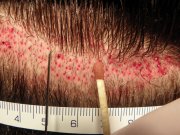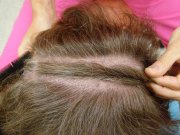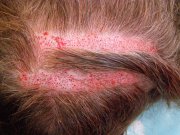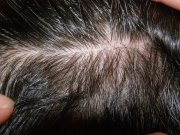1st stage ‒ Graft extraction
As soon as the client arrives at the clinic (ideally shortly before 8.00 am) and all necessary organizational have been handled, the patient is escorted to the patient room by a nurse. The room is booked just for the client throughout the course of treatment to secure comfort and necessary confidentiality. If necessary, some details of the upcoming surgery can be agreed in the patient room.
Subsequently, the client undergoes a disinfection of the scalp (hair) and is given premedication drugs (antibiotics, painkillers, antiallergic agents, prevention of excessive bleeding and overall calming). After another 10 to 15 minutes, the client arrives to an adjacent operating theatre.
First, the donor site is marked. Its hair is then cut short, to enable the removal of grafts with a micro-needle. The client then should lay comfortably on their stomach on the operating bed. At this moment the patient is ready for surgery.
The desensitisation of the donor area is carried out through an application of a cooling spray and a microinjection. This part takes about six minutes. As soon as the donor area is numb, we can begin with the extraction of individual grafts with a microdriller with a needle of a diameter of 0.60 to 0.65 mm. This phase of treatment is usually the longest, it lasts from one to three hours depending on the number of grafts. The procedure can be interrupted at any time so that the patient may drink, relax or go the restroom if necessary.
After finishing the extraction of the pre-arranged number of grafts, client leaves to the patient room, where they enjoy 20 to 30-minute break and get their "reward" in the form of sandwiches and tea or fruit.
Grafts are, from their extraction until their planting back into the skin placed in a special fluid protecting them from external influences, mainly from drying and loss of vitality. The solution contains antioxidants (vitamin C) nutrients (glucose and aminous acids) and protective chemicals (blood plasma). These are important to support healing and subsequent nutrition of the grafts during the first days following the transplant. Temperature of the grafts also plays an important role – containers with the grafts are kept in the fridge at the temperature of 4 °C.





